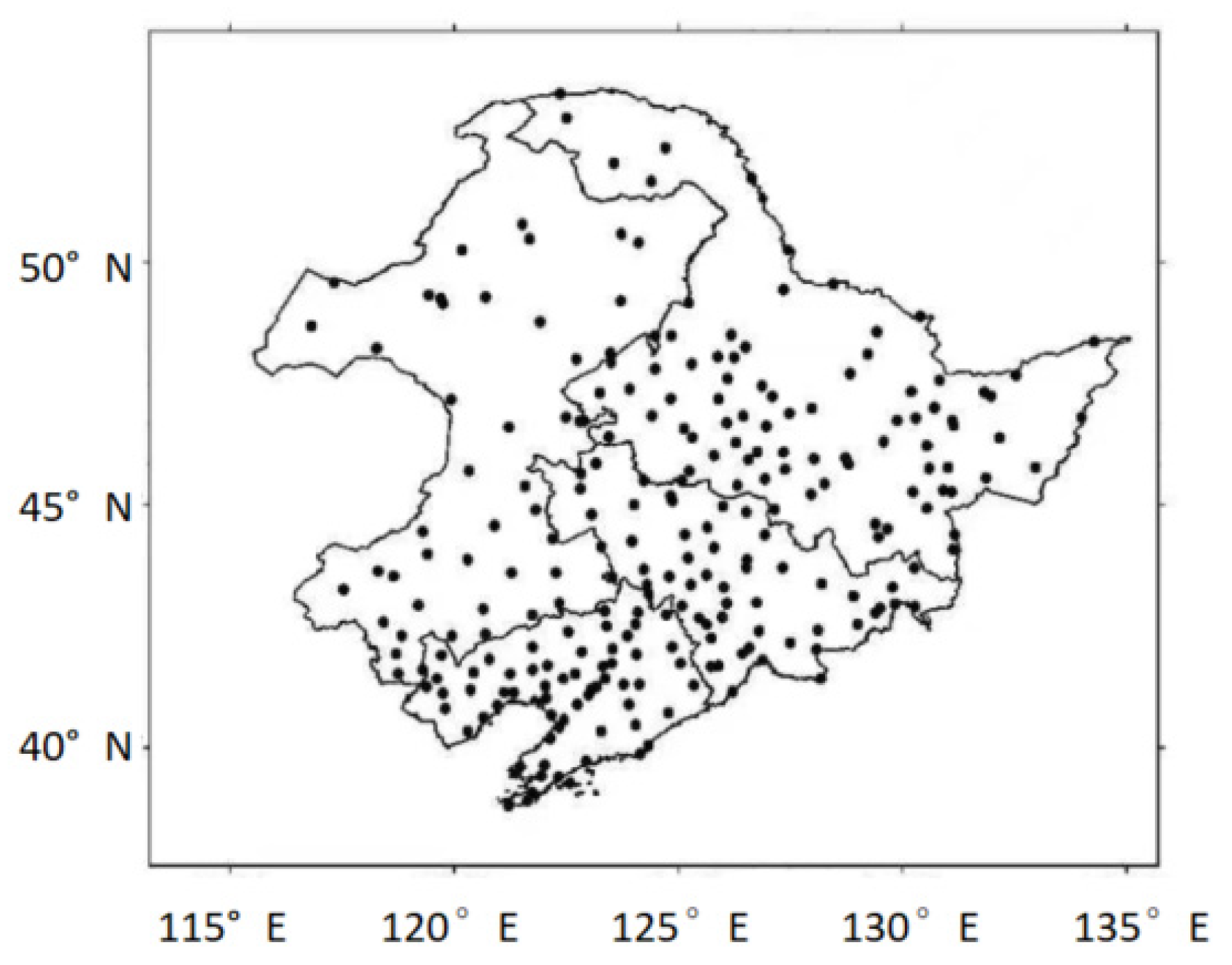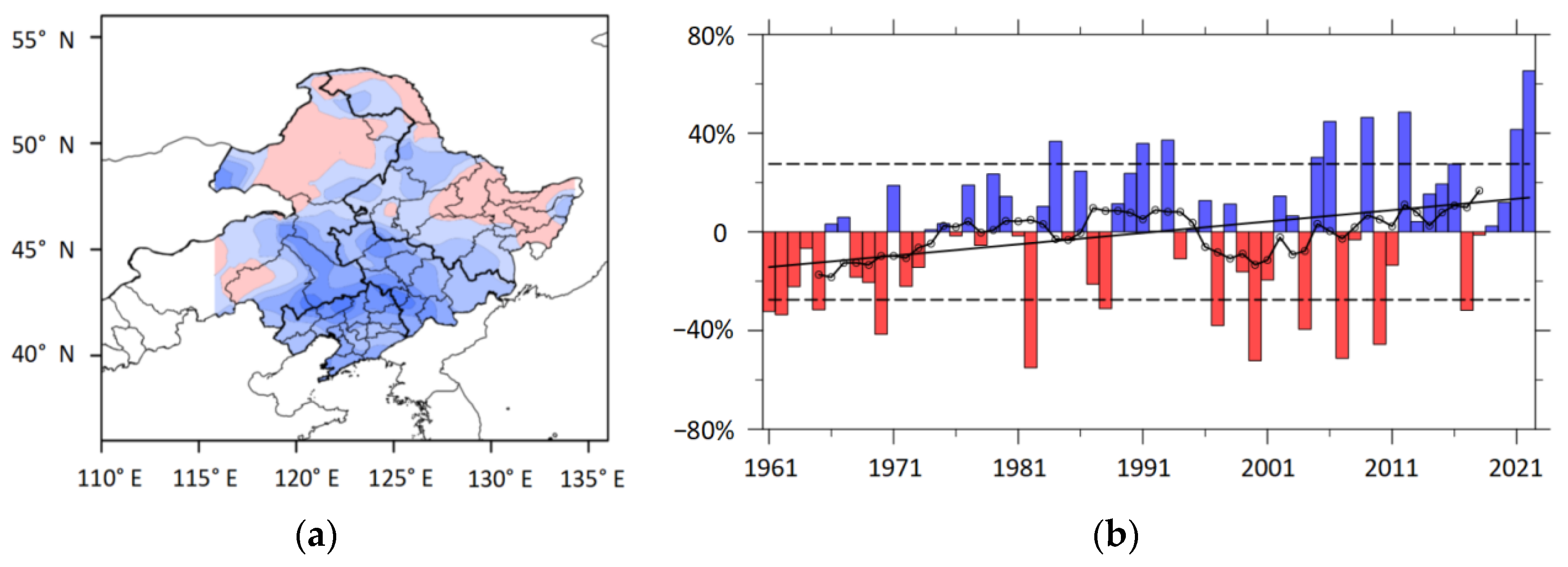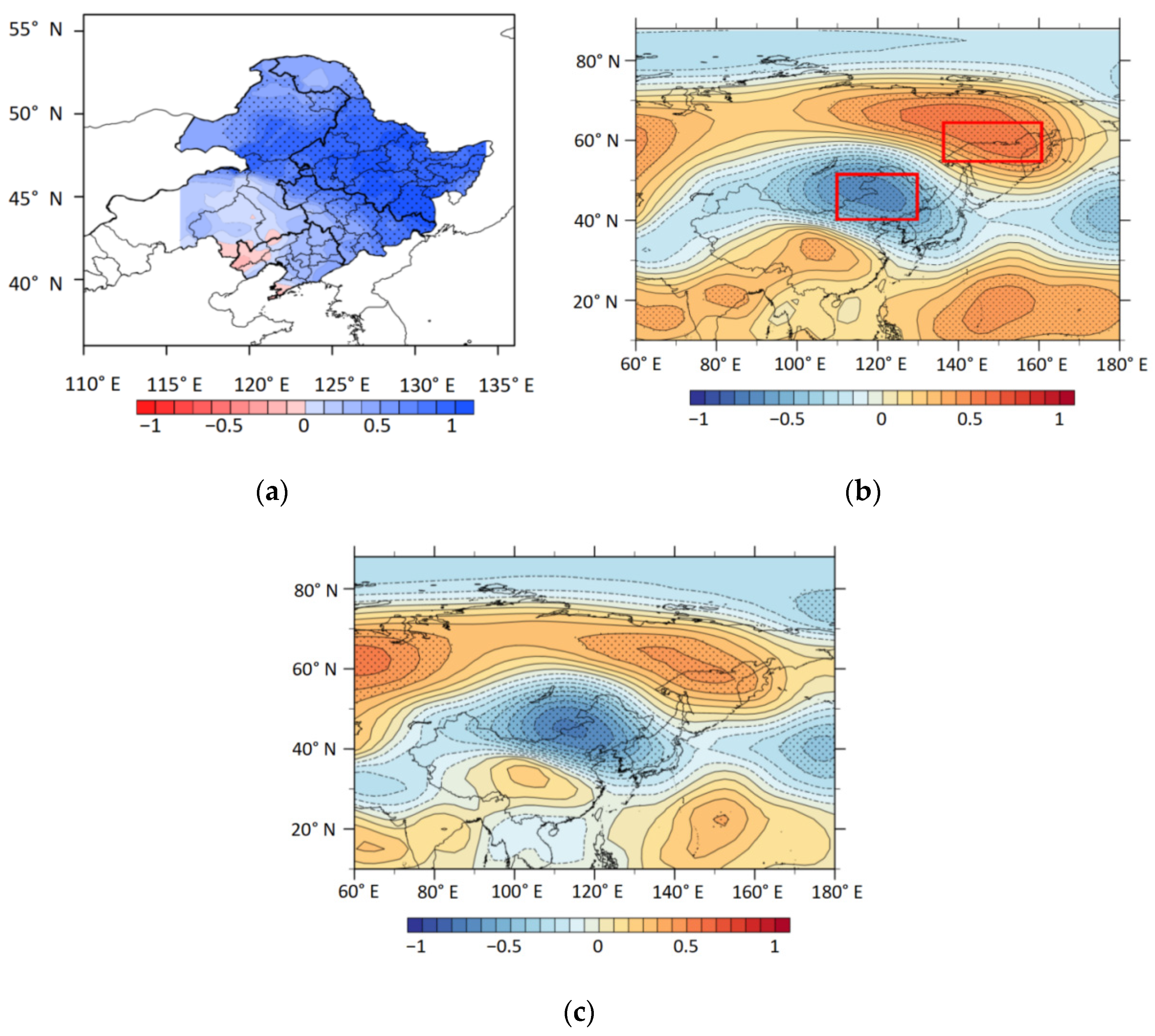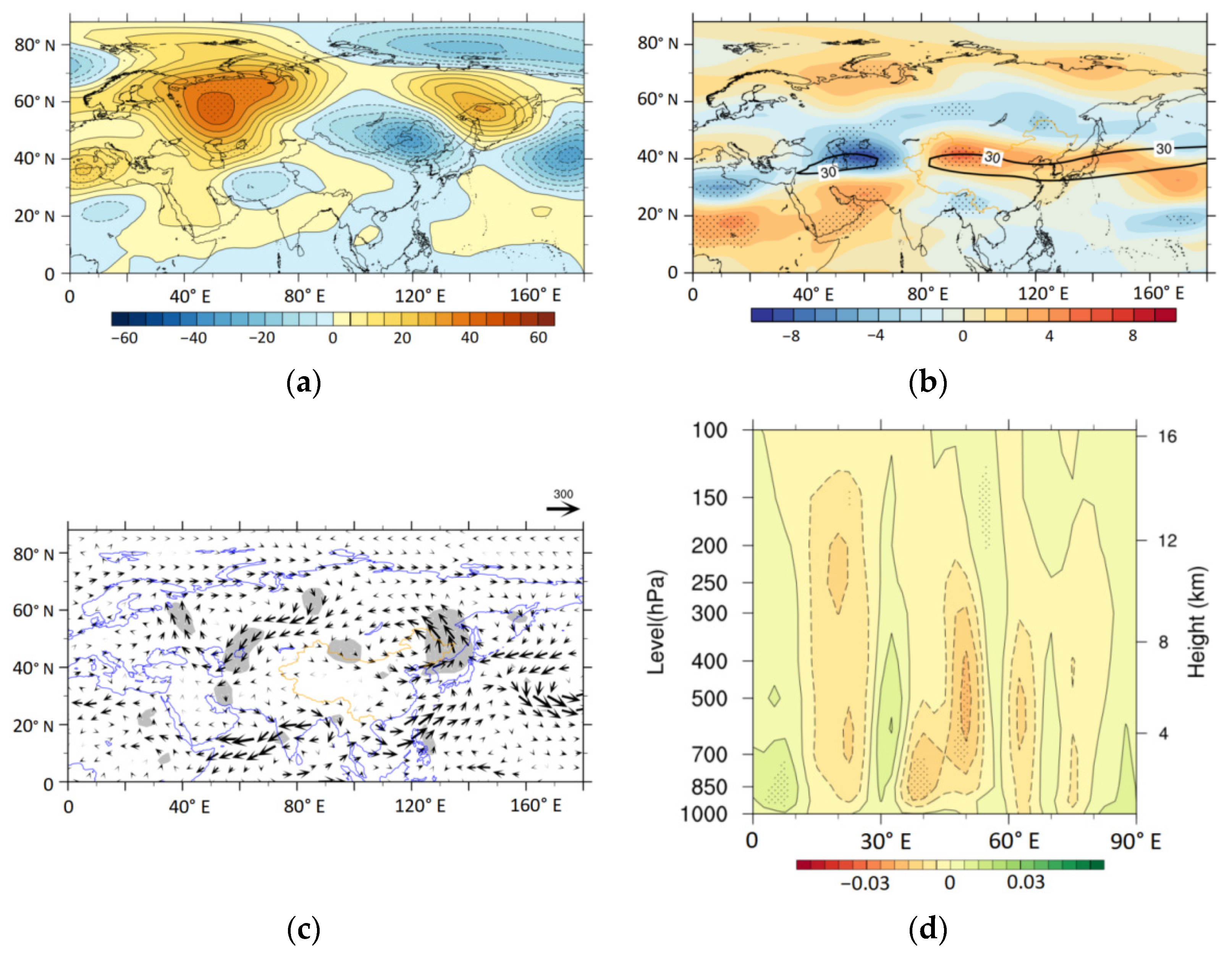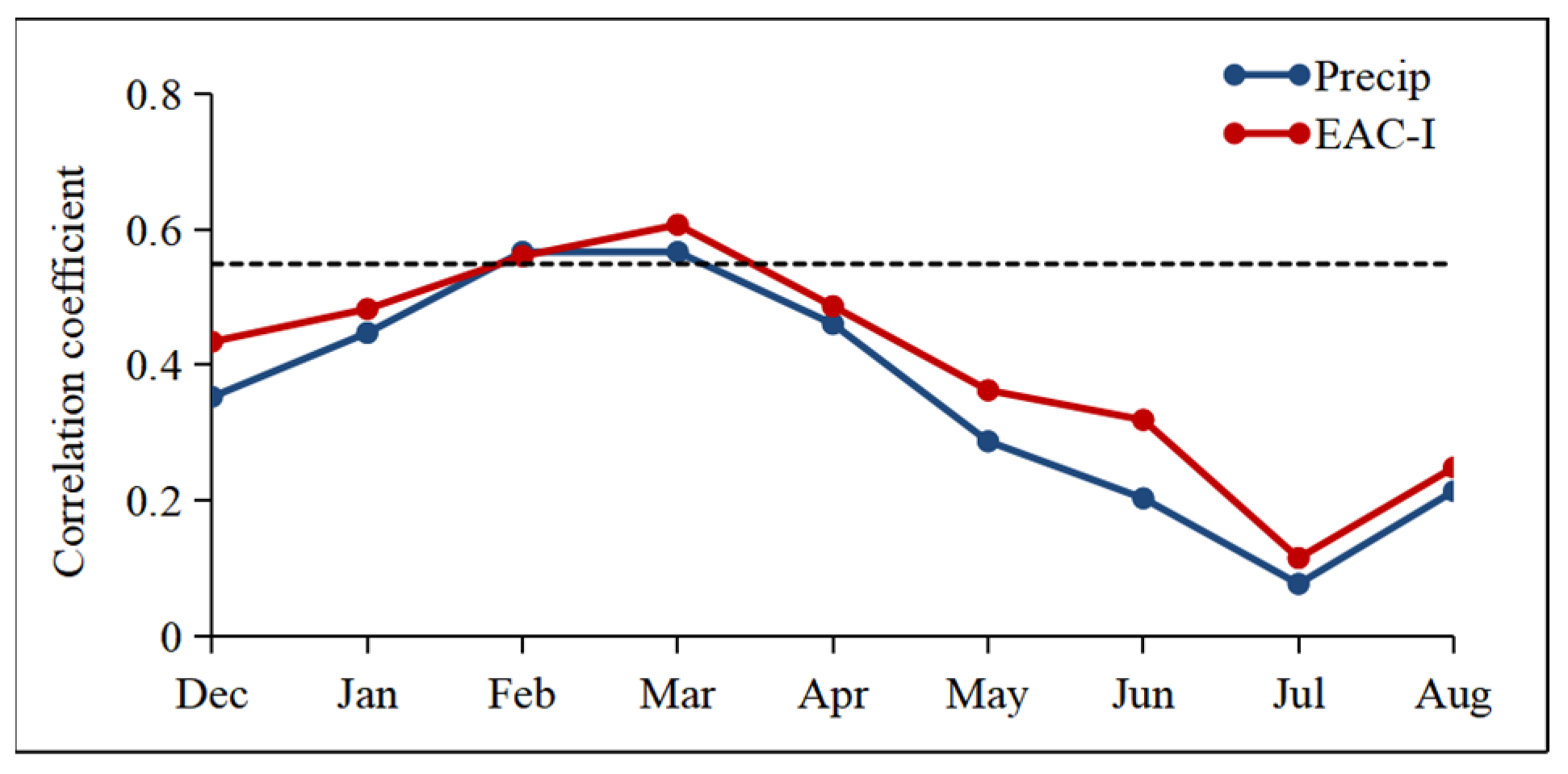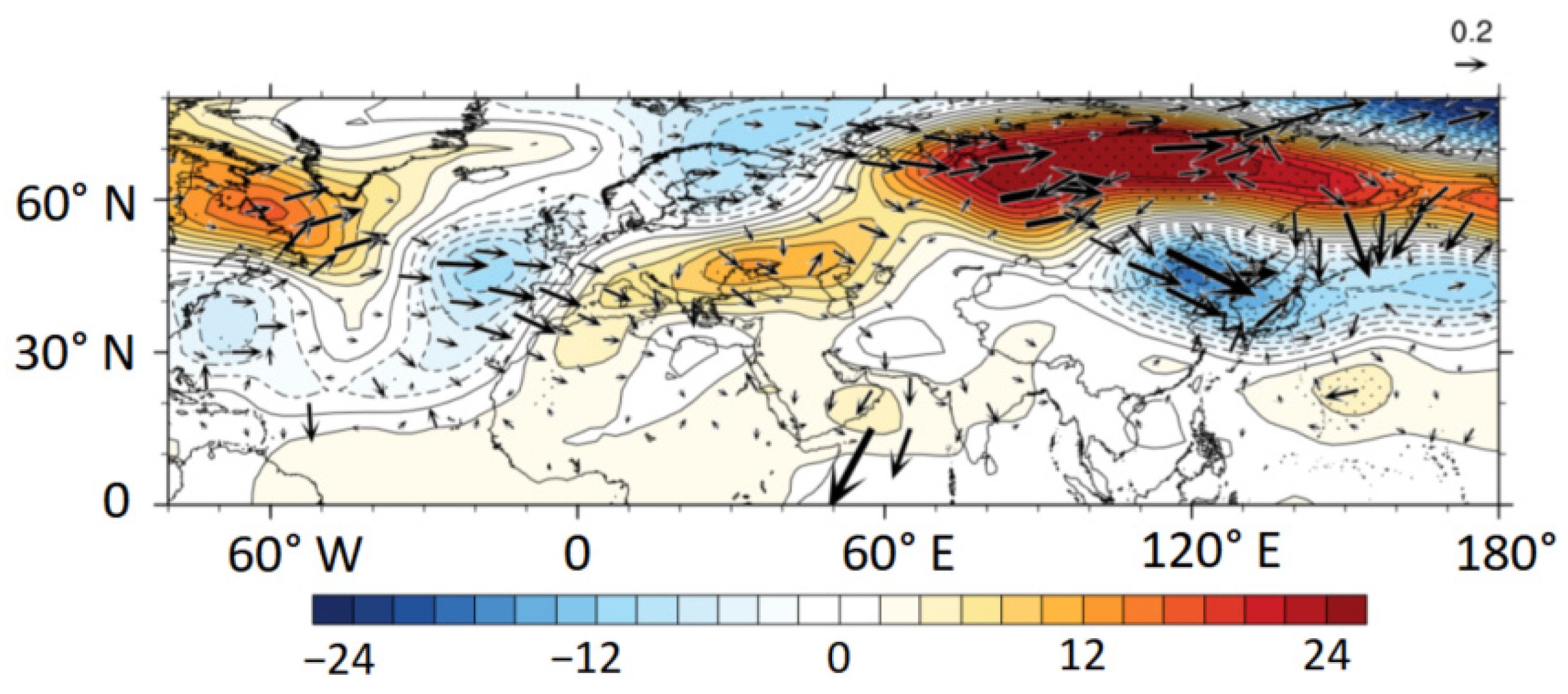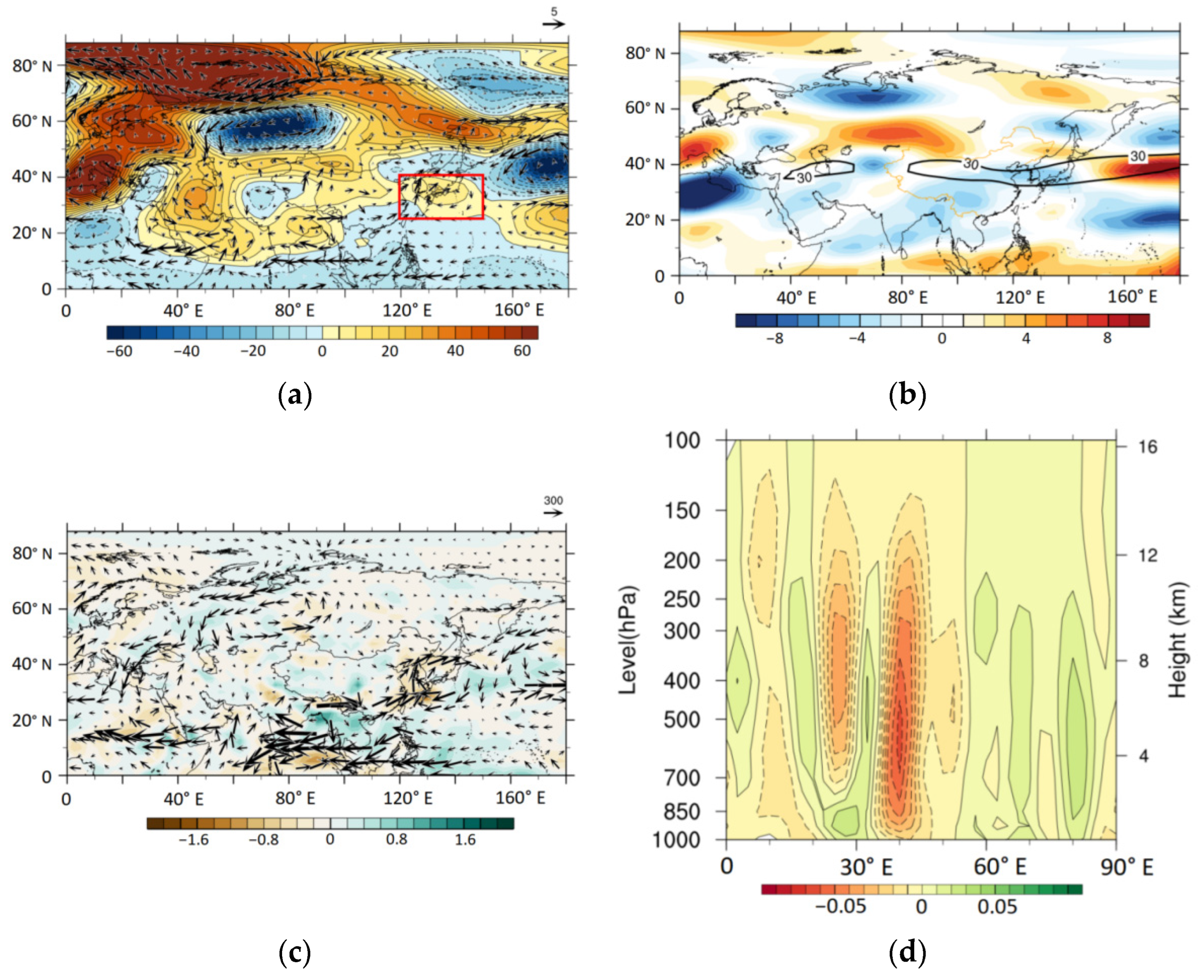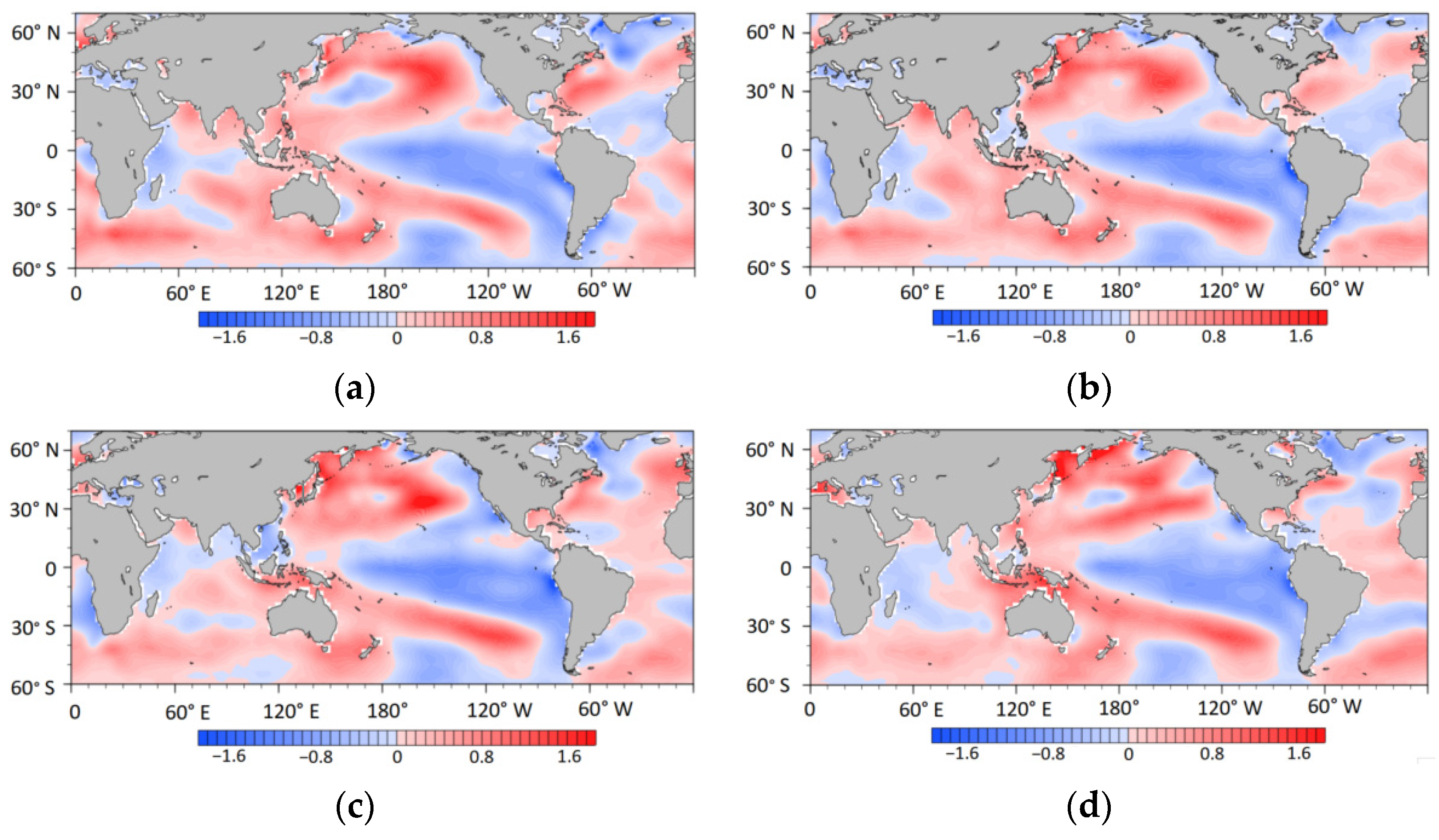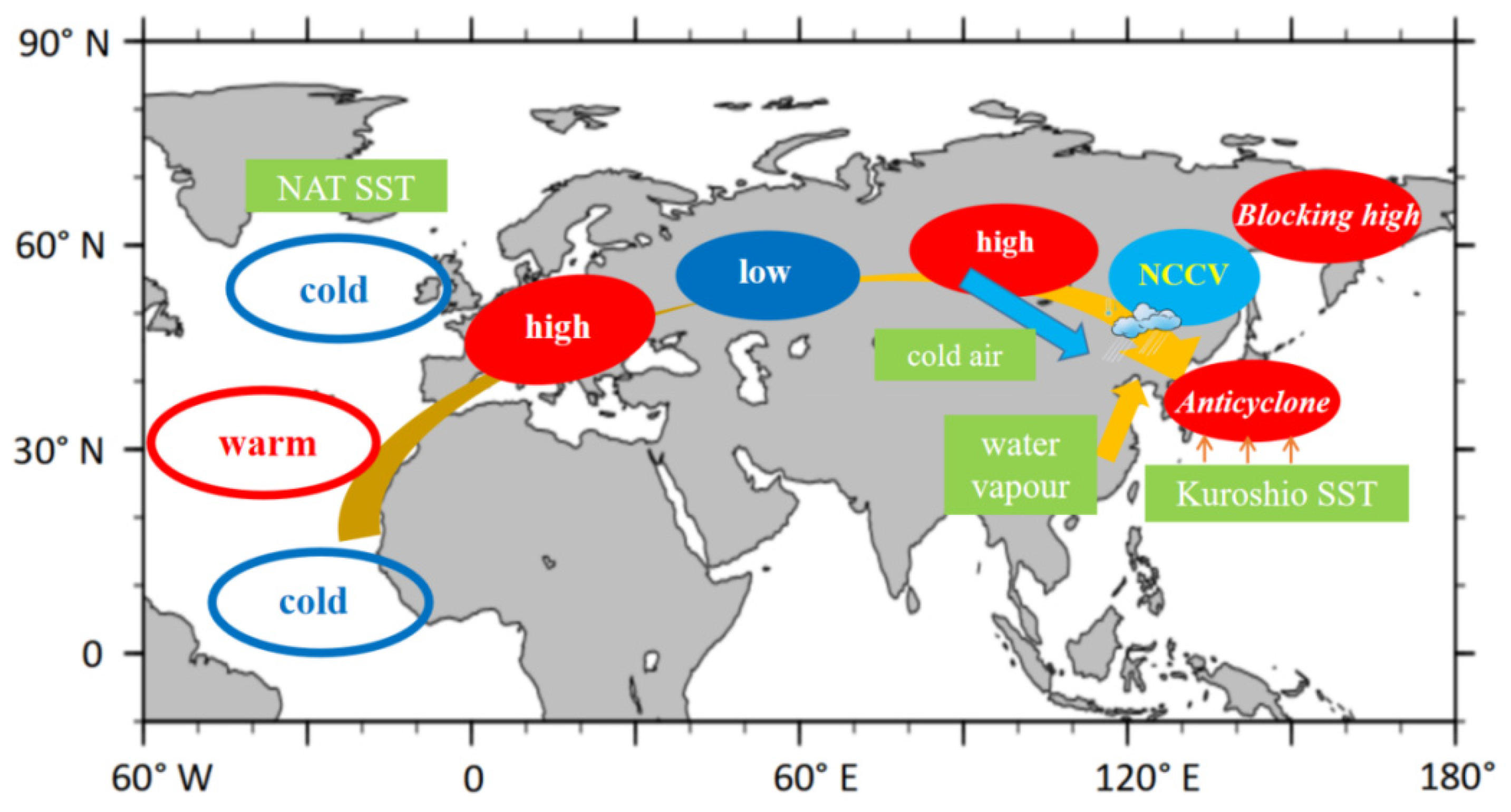1. Introduction
The average precipitation in northeast China (NEC) in the early summer (June) of 2022 was 144.9 mm, which is 60% higher than that of normal years (89.5 mm) and the highest value in available historical records since 1951. Meteorological disasters such as rainstorms, floods, hail, and strong winds have profound societal and economic impacts on NEC.
NEC is in the mid-high latitude monsoon region of East Asia. In early summer, precipitation in NEC is simultaneously affected by atmospheric circulation anomalies in mid-high latitudes, and the associated mechanism is complicated. Previous studies show that early summer precipitation in NEC is mainly affected by the northeast China cold vortex (NCCV) and blocking high in the mid-high latitudes. When the NCCV and blocking high appear simultaneously with sufficient water-vapor transport from the south, NEC tends to have more precipitation in early summer [
1,
2,
3]. The changes in critical circulation systems that affect the NEC climate, such as the NCCV, have been found to be linked to sea-surface temperature anomalies in the North Atlantic. Zuo et al. [
4] revealed the possible mechanism of the tripole SST in the North Atlantic affecting the East Asian summer monsoon. Fang et al. [
3,
5] pointed out that the North Atlantic SST tripole pattern in spring may stimulate a Rossby wave train that propagates downstream along the westerly jet stream through the air–sea interaction, leading to anomalous NCCV and blocking high in early summer, thereby affecting NEC precipitation. Lu et al. [
6] and Zhu et al. [
7] also found a close relationship between North Atlantic SST and the spring precipitation in NEC.
This paper attempts to analyze the influences of the SST forcing on the atmospheric circulation in the mid-high latitudes in the period of June and understand the causes of the unprecedented precipitation in the NEC in June 2022. The result obtained can provide a scientific basis for operational short-term climate prediction. The remainder of this paper is organized as follows.
Section 2 describes the data and methods used in this study.
Section 3 is a overview of precipitation in NEC in June 2022.
Section 4 analyses the atmospheric circulation and SST factors influencing NEC precipitation in June.
Section 5 discusses possible causes of anomalous precipitation in June 2022. Finally, the findings of the present study are summarized and discussed in
Section 6.
2. Data and Methods
Daily precipitation data from 245 meteorological stations over NEC (
Figure 1), including the provinces of Heilongjiang, Jilin, Liaoning, and eastern Inner Mongolia, of the Chinese Meteorological Administration (CMA) from 1961 to 2022 were used to describe the variability in precipitation over NEC. Monthly geopotential height, wind field, vertical pressure velocity, and specific humidity with 2.5° × 2.5° horizontal resolution were obtained from the National Centers for Environmental Prediction/National Center for Atmospheric Research (NCEP/NCAR) reanalysis [
8]. Sea-surface temperature with 2° × 2° horizontal resolution was obtained from the National Oceanic and Atmospheric Administration Extended (NOAA) Reconstructed SST version 5 [
9].
Statistical methods, including linear correlation analysis, singular value decomposition (SVD), regression analysis, and composite analysis methods, are also used. The statistical significance level is assessed using the two-tailed Student’s t-test.
3. An Unprecedentedly Rainy Early Summer in NEC in 2022
In June 2022, the spatial mean precipitation in NEC is 144.9 mm, which is 62% higher than normal and the highest value in available historical records since 1951. Among them, the average precipitation in June 2022 in Jilin and Liaoning Provinces broke through historical records.
Figure 2a shows the spatial distribution of the anomaly percentage of precipitation in June 2022. Except for the northern region of NEC, positive precipitation anomalies generally prevail in the entire NEC, with a maximum precipitation center in the south-central NEC. The precipitation of many stations in June exceeds 350 mm, which is close to or even exceeds their mean total rainfall during the whole summer (including June, July and August).
Figure 2b shows the time series of the percentage of NEC precipitation anomalies in June. It can be seen that the precipitation in June has shown a significant (
p < 0.05) upward trend since 1961. Notable interdecadal variation in the precipitation in June of NEC can be found in its 9-year sliding mean time series. The values for the rainy years in June is obviously high since 2001, and the top five years for precipitation (2006, 2009, 2012, 2021, and 2022) occur in this period.
5. Possible Causes of Anomalous NEC Precipitation in June 2022
NEC precipitation in June 2022 was more than normal. Based on the analysis above, the cause of the abundant precipitation in June 2022 in NEC is further diagnosed. It can be seen from the 500 hPa geopotential height anomaly field in June 2022 (
Figure 9a) that there are obvious zonal wave trains over the mid-high latitudes of Eurasia with negative anomalies in NEC and positive anomalies in the Okhotsk Sea, which corresponds to the NCCV and the BHOS cooperating pattern in mid-high latitude favoring NEC precipitation. However, a positive geopotential height anomaly occurs in southern Japan, which is too strong and too north compared with the typical circulation of heavy rainfall years. The southerly flow to the western flank of the anomalous anticyclonic circulation is conducive to northward water-vapor transport. The anomalous vertically integrated water-vapor flux and divergence (
Figure 9c) further suggests that the water vapor for NEC precipitation in June mainly comes from the offshore regions of eastern China and is continuously transported to the southern NEC by the southerly in the western flank of the anomalous anticyclone. However, the westward water-vapor transport from the vicinity of the Okhotsk Sea is relatively weak. NEC is basically controlled by the convergence area of water vapor, but the area with strong convergence is in the southern NEC and thus more precipitation occurs in the south. At the same time, the subtropical westerly jet is strengthened at around 60° E to 110° E and 120° E to 180° E, and a break occurs over NEC, implying that the southwestern NEC is located just to the right side of the upper-level jet entrance area in its eastern segment. As a result, there is an ageostrophic wind divergence at the upper level, which is conducive to the development of ascending motion (
Figure 9b). The vertical velocity profile along 120° E also shows that the ascending motion is strong near 40° N in the southern NEC and gradually weakens northward (
Figure 9d). With the aid of the favorable dynamic and water-vapor conditions in the mid-lower troposphere, anomalous precipitation occurs in NEC with a maximum center shifting southward.
It is pointed out in
Section 4.2 that the NAT SST anomaly in March is a clear indicator of an NEC precipitation anomaly in June during 2001–2021, which provides a theoretical basis for explaining the unprecedented precipitation in NEC in June 2022 from the perspective of SST forcing. In March 2022, the North Atlantic Ocean showed an obvious tripole SST anomaly (
Figure 10a), which is consistent with the correlation distribution of SST between NEC precipitation in June and EAC-I (
Figure 6). Although its intensity weakens gradually, the tripole SST distribution can persist to June. This indicates that the NAT SST anomaly in March 2022 may stimulate the Rossby wave propagating eastward from the North Atlantic to the North Pacific through the air–sea interaction mentioned in
Section 4.2, generating the anomalous circulation pattern in which the NCCV cooperates with the BHOS in the mid-high latitudes of East Asia. Hence, a background atmospheric circulation pattern favorable for more precipitation in NEC is formed.
It is worth noting that although NAT can excite the circulation pattern favoring NEC precipitation in June, the corresponding anomalous anticyclone in the northwestern Pacific is slightly southward (
Figure 8) compared to that which occurred in June 2022 (
Figure 9a), which is located at around 30° N. To investigate the reason for the northward deviation of the anomalous anticyclone in June 2022, we further defined a northwest Pacific anomalous anticyclone index (NPA-I, see
Table 1) in southern Japan. In
Figure 11a, the correlation between NPA-I and SST shows that the anomalous anticyclone at 500 hPa over southern Japan in June was closely related to the positive SST anomaly in the Kuroshio region (defined in
Table 1). In the subtropical region, convection tends to be suppressed. Although there are warm SST anomalies in the Kuroshio region, they cannot stimulate local convective heating, but heat the atmosphere through long-wave radiation, generating a warm high by air-column stretching [
13]. A significant positive turbulent heat flux anomaly in the sea to the south of Japan can be seen from the regressed sea-surface turbulent heat flux in June against NWP-I (
Figure 11b). The sea-surface turbulent heat flux is the sum of sensible heat flux and latent heat flux. A positive turbulent heat flux anomaly indicates that the ocean transfers heat to the atmosphere, whereas a negative anomaly means that the atmosphere transfers heat to the ocean. The results suggest that the anomalous SST warming in the Kuroshio region in June may increase the geopotential height over the northwestern Pacific by transferring heat to the atmosphere. A Kuroshio Sea temperature index in June (KS-I, see
Table 1) was then defined, and the regressed geopotential height at 200, 500, and 850 hPa against the KS-I index is shown in
Figure 12. There are significant negative geopotential height anomalies in the three levels to the north of Japan. The geopotential height shows a meridionally distributed positive-negative-positive pattern with a significant positive geopotential height anomaly near 30° N, which is more evident in the mid-upper layers.
In summary, NEC precipitation in June 2022 is more than normal. Statistically, on the one hand, it is modulated by the NAT anomaly in March. The NAT anomaly stimulates the downstream circulation pattern consisting of the NCCV and the BHOS in the mid-high latitude, which is conducive to the frequent convergence of cold and warm air in NEC and favors heavy rainfall. Moreover, the SST anomalies in June in the Kuroshio region, through the local air–sea interaction, can make the anomalous anticyclone in the northwestern Pacific more northward and stronger compared with the typical heavy precipitation circulation pattern, which provides sufficient water vapor from northwestern Pacific for NEC, resulting in the unprecedented precipitation in June 2022.
6. Conclusions and Summary
In June 2022, the spatial mean precipitation in northeastern China (NEC) broke the historical record. Through the statistical analysis of the associated large-scale circulation pattern and SST anomalies, the following conclusions are obtained:
(1) In the past 20 years, the mid-high latitude atmospheric circulation pattern that consists of the NCCV and the BHOS is the primary large-scale circulation factor affecting the precipitation anomaly in June of NEC, which is closely related to the NAT SST anomaly in March. During the years of more NEC precipitation in June, the active NCCV and BHOS provide thermodynamic and water-vapor conditions for the anomalous precipitation.
(2) In June 2022, there were cooperating NCCV and BHOS in the mid-high latitude of East Asia, as well as an anomalous northerly and strengthened northeast Pacific anticyclone. The southerly flow to the western flank of the anomalous anticyclonic circulation was conducive to northward water-vapor transport, while the westward water-vapor transport from the vicinity of the Okhotsk Sea was relatively weak. The subtropical westerly jet over the northwestern Pacific was strong with a break occurring over NEC, which is conducive to the development of an ascending motion. With the aid of the favorable dynamic and water-vapor conditions, anomalous precipitation occurred in NEC.
(3) The NAT SST anomaly in March 2022 stimulated eastward-propagating wave energy through air–sea interaction, resulting in the anomalous circulation pattern in which the NCCV cooperated with the BHOS in the mid-high latitudes of East Asia. Based on the background atmospheric circulation favorable for precipitation, the SST warming of the Kuroshio in June lead to a more northward and stronger anomalous anticyclone in the northwestern Pacific, which provided more water vapor for NEC, resulting in unprecedented precipitation in June 2022 (
Figure 13).
The results are based on statistical analysis. Fang et al. [
3] have conducted a series of numerical experiments related to the conclusion, which can provide further support for the results of this paper. In addition, we noticed that although the configuration of the atmospheric circulation for ten days of June 2022 is basically the same as that of the whole month, there are also specific differences in the atmospheric circulation pattern for every ten days. This paper analyzes the impact mechanism of SST signals on the atmospheric circulation on a monthly time scale; the situation every ten days of June may need to be examined separately. Moreover, here we mainly focus on the influences of previous SST on atmospheric circulation in the mid-high latitudes which may also provide guidance for the long-range prediction of NEC precipitation, while snow cover influences in the Qinghai-Tibet Plateau [
14], and Arctic Sea ice [
15,
16] may also play an important role. The synergistic effects of different signals deserve further analysis.
